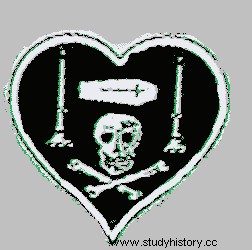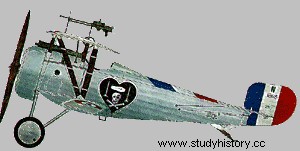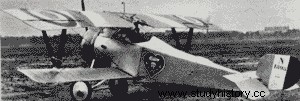Victory
43
Biography
Paris, 1882 - died in the North Atlantic in 1927.

Born in Paris, March 15, 1892, Charles Nungesser spent his childhood in Valenciennes where he learned mechanics and electricity. He dreams of escape and wide open spaces:Argentina seems to suit him. He leaves and, in this country barely touched by civilization, throws himself headlong into the riskiest adventures:rodeos, automobile or motorcycling races, boxing fights... August 1914, the mobilization brings Charles back to France. He was assigned, as a simple horseman, to the 21 Hussar Regiment. Less than a month after his incorporation, the rider Nungesser is talking about him. Alone, like a lost child, he crossed the lines and fell, on September 3, 1914, on a powerful Mors automobile carrying four senior German officers carrying plans for an attack in preparation. Nungesser captures the colorful group, ties his horse behind the car, and triumphantly returns to the French lines at the wheel of the Mors. He will need a lot of cunning so that, as a simple horseman, he can lead his war prize to the headquarters of the sector. He will succeed anyway and hand over his four prisoners and their precious plan to the general himself. This general, whose name history has not preserved, was probably a follower of Alphonse Allais because he baptized Nungesser "the hussar of the Mors" and, as he was also generous, he gave the car to the rider and authorized his immediate transfer to the air force, reserved at the time for a social elite of which Charles was not a part.

January 21, 1915, the doors of the Avord school open before Nungesser. It will not last forever in this nursery of illustrious pilots. Five days after his arrival, he was released solo, obtained his patent on March 2, 1915 and six days later found himself incorporated into the VB 106 squadron, in Saint-Pol-sur-Mer, at the controls of a Voisin bomber. X. On April 15, he took off for his first war mission over Ostend. He is accompanied by a bombardier mechanic, a handyman:Pochon. A couple that only death will separate has just been formed. Never again will the brave Pochon abandon Charles Nungesser, through the terrible years they will face together. On April 26, he bombed Roeselare. On his return, he puts an overly curious Albatross to flight, but his neighbor is hit by four large shrapnel. It must land at Poperingues. Nothing serious. He changes a wheel and returns at night to Dunkirk. On May 1, shrapnel lodged between his mountain pass and his helmet...
VB 106 leaves for Nancy. On July 30, Charles Nungesser must perform a test flight on a Voisin. Just before his departure, six "Boches" were reported on Pont-à-Mousson. He did not hesitate for a second. He takes off for his "test flight", which, coincidentally, allows him to cut off the retreat of an Albatros returning from bombarding Bézaumont's captive balloon. He hit it with several bullets which perforated the left radiator and the water pipe. The Albatross cannot rejoin its lines and lands in disaster, between the trenches. Nungesser exults. His first victory! She earned him the Croix de Guerre... and eight days of arrest for having acted without orders! On August 11, 1915, he was detached to Le Bourget to test various aircraft. He returns to his squadron on the last day of the month aboard a Morane Parasol "Type Garros", that is to say equipped with a machine gun that can fire through the field of the propeller. He will hardly have the opportunity to use this aircraft and, after a short stay in Bron to fly on Caproni, he is detached, on October 27, 1915, to the squadron N 65 which, under the orders of captain Féquant , operates from the plateau de part every day, alone, making what was called at that time an "offensive cruise", during which he combs the entire sector in search of the "Boche".
It sometimes flies more than five hours a day and frequently engages the enemy, but in many cases it cannot observe the fate of its victims. The rigors of official approval thus deprive it of many almost certain victories. He is not a tactician, but a go-getter. It stings to death on its prey and closes its eyes when it shoots. He never knows what he'll see when he opens them again... if he opens them again:his victim in flames, the ground approaching or a hospital room! He decorated the sides of his "Baby" Nieuport with a badge of macabre humor to justify his nickname "Hussard de la Mors". He spent the week of November 21 to 29, 1915, mounting a machine gun on the hood of his Nieuport which will shoot through the field of the propeller. He is not unhappy with the result, although he cannot really judge its effectiveness, since, on January 4, 1916, he catches a Fokker who nevertheless manages to give way to him on the fifth pass above Château- Saline.

On January 17, at the controls of a Caproni, he flipped over landing at Pont-Saint-Vincent. He is taken to the hospital. He only leaves to... return. On January 29, 1916, while piloting the prototype of a Ponnier fighter, he suffered a serious accident. The broomstick breaks his jaw and fractures his palate. His two legs are crushed and he suffers from multiple bruises and wounds. Anyone else would have been lost to the air force... but not Charles Nungesser Two months later, on March 28, he left the hospital on two crutches, with a huge bandage around his head. The next day, he is back at the squadron. He can't walk? Never mind ! Pochon carries him in his Nieuport and helps him get out after each mission. On April 3, during the same outing, he engaged in combat three times. Twice without concluding:above Etain, then Bois-Bourru. The third is the good one. He shoots down a reconnaissance plane near Cumières. The next day, he shot down a twin engine near the Etang des Hauts-Fourneaux. This fifth victory, he celebrates it in the hospital, because his old wounds have reopened. We must once again reduce his fractures and it is in the hospital that he receives his stripes of second lieutenant. On April 24, 1916, he was back at the front, on the Béhonne plateau, near Bar-le-Duc. The next day, he shot down an LVG in the French trenches, north of Verdun. Then, he chases a second one for nearly an hour and manages to hit him as he crosses his lines. The German's engine stalled but he managed to land on the Cuisy field. Two days later, he came up against seven German aircraft alone:four LVGs, protected by three Fokker monoplanes. Nungesser chooses an LVG and shoots it down in flames near Spincourt. The hunters then react, but Nungesser narrowly escapes them. His Nieuport received 18 bullets, several of which hit the engine. It is good for scrap. Then begins the terrible battle of Verdun. The N 65 squadron was bled dry and lost four pilots in three days, from May 19 to 21. On June 22, he attacked two Aviatiks head-on. After an hour of a very hard fight, Nungesser kills them one after the other. But the Frenchman's device was mistreated. Its engine gives up the ghost. He landed in the barbed wire and rolled over in a shell hole. He is again injured in the head, right arm and left knee. Another hospital stay. He returned to the front and, on July 22, 1916, attacked two German planes:he shot down an Aviatik near Les Eparges. He learns later that this device was piloted by Otto Parschau, ace with 8 victories, holder of the cross "Pour le Mérite".

Former WWI fighter ace with 43 approved victories, this pilot decided in May 1927 to attempt the crossing of the Atlantic non-stop. Associated with his teammate Coli*, he directs a biplane, the White Bird, which takes off from s Bourget on May 8 at dawn. The next day, May 9, false information prompted the newspaper La Presse to announce the company's success. In fact, the white bird disappears at sea body and goods.
